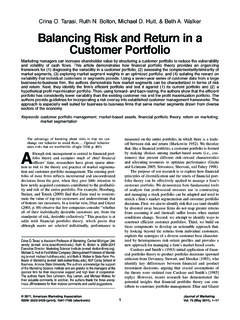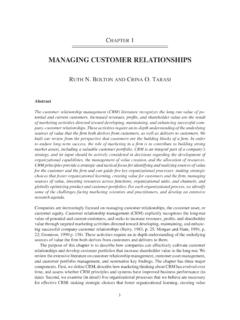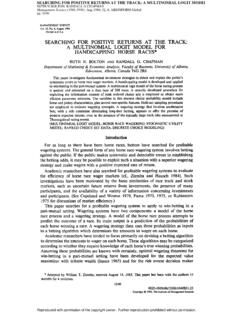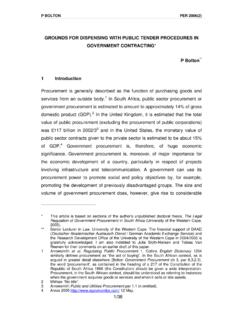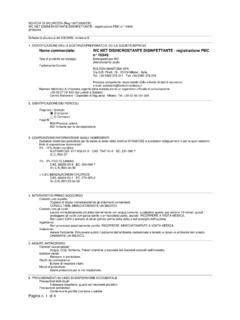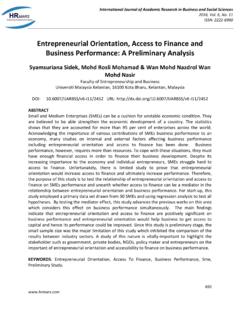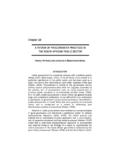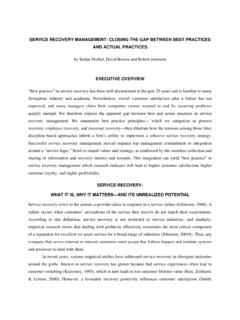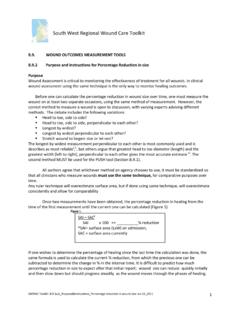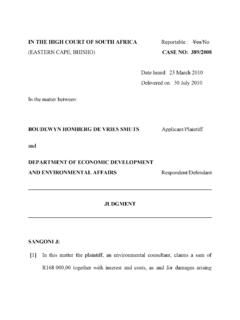Transcription of A Cross-National and Cross-Cultural Approach to …
1 A Cross-National and Cross-Cultural Approach to Global Market Segmentation: An Application Using Consumers' Perceived Service Quality James Agarwal, Naresh K. Malhotra, and Ruth N. Bolton ABSTRACT. The spread of global culture is being facilitated by the proliferation of transnational corporations, the rise of global capi- talism, widespread aspiration for material possessions, and the homogenization of global consumption. The extent of convergence of cultural values across nations has been debated by international marketing researchers. However, from a practical standpoint, transnational firms require a Cross-National , Cross-Cultural Approach to market segmentation that can be used to guide the development of global marketing strategies. In this study, the authors investigate the appli- cation of Cross-National versus Cross-Cultural approaches to market segmentation through a rigorous empirical investi- gation in the context of banking services.
2 Although services constitute the fastest growing sector of the world economy, few studies have examined global market segmentation strategies for them. The authors develop theory-based cross - national hypotheses and test them by estimating a structural model of consumers' perceived service quality using survey data from two countries: the United States and India. They test Cross-Cultural hypotheses by estimating the same model on culture-based clusters. They demonstrate that there are distinctive differences between Cross-National and cross - cultural models of perceived service quality and highlight the growing relevance of Cross-Cultural research approaches. More generally, the Cross-National , Cross-Cultural Approach to market segmentation can guide the development of global marketing strategies for services and improve business performance.
3 Keywords: Cross-National research, Cross-Cultural research, global market segmentation, perceived service quality, structural equation modeling iven the rapid pace of globalization, turbulent racy and freedom of choice, individual rights, accept- G economic and political changes, and the domi- nance of multinational corporations, values of global culture such as a free market economy, democ- ance and tolerance of diversity, and openness to change are steadily sweeping global markets (Gupta and Govindarajan 2000; Leung et al. 2005). The spread of global culture has been facilitated through the prolif- eration of transnational corporations, the rise of global James Agarwal is Associate Professor of Marketing, Haskayne School of Business, University of Calgary (e-mail: james.)
4 Capitalism, the widespread aspiration for material pos- sessions, and the homogenization of global consump- tion (Ger and Belk 1996). Despite doubts about cultural Naresh K. Malhotra is Nanyang Professor, Nanyang Business convergence across countries as a result of globalization School, Nanyang Technological University, Singapore, and Regents' Professor Emeritus of Marketing, College of Man- agement, Georgia Institute of Technology (e-mail: naresh. Journal of International Marketing 2010, American Marketing Association Ruth N. Bolton is 2009 2011 executive director, Marketing Vol. 18, No. 3, 2010, pp. 18 40. Science Institute (e-mail: ISSN 1069-0031X (print) 1547-7215 (electronic). 18 Journal of International Marketing ( , Bhagat et al. 2003; Greider 1997), we believe that investigation in the domain of international services global trends have increased the heterogeneity of atti- marketing with specific application to consumers' per- tudes and behaviors of consumers within countries and, ceived service quality (PSQ).))
5 Global services marketing at the same time, increased commonalities across coun- requires that organizations customize their marketing tries (Ter Hofstede, Wedel, and Steenkamp 2002). activities to meet the common needs and preferences of Although national cultures endure over time and they market segments or homogeneous consumer groups. are still valid as collective identities (Hofstede 1991), Services (rather than goods) are especially good candi- there will be similarities across nations in culture- dates for customization, but international services pose specific beliefs and attitudes related to work practices special challenges for marketing managers because of and consumption patterns. In this study, we highlight the intangibility of services, difficulties in standardizing the growing relevance of networks of communities services across national borders, and the extent of differ- across countries that create culture and share similar ences in perceptions of and preferences for customized values and lifestyles (Adams and Markus 2004).
6 Our services across countries and cultures (Szymanski, goal is to develop a Cross-National , Cross-Cultural Bharadwaj, and Varadarajan 1993). Therefore, cus- Approach to market segmentation that can be used to tomization of services in global markets requires that guide the development of global marketing strategies. organizations develop a deep understanding of how consumer perceptions of service quality differ across The distinction between country and culture as a unit of and within regions, countries, and cultures. analysis has managerial implications in global market- ing, in which organizations must effectively distinguish In general, prior research on PSQ has adopted a cross - between vertical market segments, which exist within national perspective in which countries have been used national borders or a region ( , Cross-National analy- as proxies for national cultures without specifically sis), and horizontal market segments, which exist across incorporating the role of culture ( , Brady et al.)
7 2005;. a group of countries that share certain characteristics Keillor, Hult, and Kandemir 2004; Laroche et al. 2004). ( , Cross-Cultural analysis) (Bolton and Myers 2003; Only a few studies have examined the role of cross - Ter Hofstede, Steenkamp, and Wedel 1999; Tung 2008; cultural influences on PSQ ( , Donthu and Yoo 1998;. Yavas, Verhage, and Green 1992). Thus, international Malhotra et al. 2005; Mattilla 1999; Winsted 1997). market segmentation must address the possibility of However, even in these studies, although cultural dimen- behavioral heterogeneity and homogeneity within and sions have been measured and used in assessing PSQ, across countries and cultures (Broderick, Greenley, and the unit of analysis has largely remained at the country Mueller 2007; Tung 2008; Yavas, Verhage, and Green level.
8 To address this gap, we investigate whether there 1992). cultural groups and phenomena across countries are significant differences in conducting Cross-National are subject to global culture's continual influence, which versus Cross-Cultural research using PSQ as an illustra- reshapes individuals' personal cultures, thereby tive example to highlight its significance as a basis for strengthening the etic validity of horizontal global seg- global segmentation. ments (Eckhardt and Houston 2007; Kjeldgaard and Askegaard 2006; Malhotra, Agarwal, and Peterson The article is organized in the following way: In the next 1996). For example, Heuer, Cummings, and Hutabarat section, we briefly discuss Cross-National and cross - (1999) find that continuous economic development over cultural research, as well as their theoretical underpin- a period of 30 years in Indonesia resulted in an unprece- nings.
9 Then, we develop hypotheses regarding how the dented sociocultural transformation: Namely, the cul- dimensions and consequences of consumers' PSQ differ tural difference between and Indonesian managers in importance in both Cross-National and Cross-Cultural in terms of individualism and power distance declined research paradigms. Next, we test the Cross-National over time. If cultures and values of the various locales of hypotheses by estimating a structural model of con- the world are indeed converging (Ralston 2008), hori- sumers' PSQ for banks with consumer survey data from zontal market segments should become increasingly the United States and India. We also test the cross - prevalent, and global marketing strategies should cultural hypotheses by estimating the same model on become more similar across nations.
10 Culture-based clusters instead of countries. The study shows that there are distinctive differences between In this research, we explore the Cross-National versus Cross-National and Cross-Cultural models of PSQ. Our Cross-Cultural research debate through an empirical findings highlight the growing relevance of cross - Global Market Segmentation 19. cultural research. We show how our results can be used when environmental changes and situational contingen- to derive managerial insights into the identification of cies precipitate adaptation and cultural change. During vertical and horizontal market segments based on differ- these contingencies, national culture fails to adequately ences in consumer perceptions across countries and account for either intracultural or global-level variables cultures.
